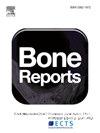Lifetime follow-up of an adult patient with pediatric-onset hypophosphatasia complicated with advanced chronic kidney disease
IF 2.6
Q3 ENDOCRINOLOGY & METABOLISM
引用次数: 0
Abstract
Hypophosphatasia (HPP) is a rare inborn-error-of-metabolism caused by mutations in the ALPL gene, resulting in deficient activity of tissue-nonspecific alkaline phosphatase and impaired skeletal mineralization. Affected individuals have a higher prevalence of chronic kidney disease (CKD) than the general population. We report a woman who underwent craniosynostosis surgery in infancy and lost her deciduous teeth prematurely. From age 27, she experienced recurrent foot pain due to multiple metatarsal fractures. Low levels of total alkaline phosphatase (ALP) was noted at 39 years of age, and low activities for the three bone-specific ALP (BALP) isoforms B/I, B1 and B2. Genetic analysis revealed 2 missense variants in the ALPL gene (p.Glu191Lys and p.Gly456Arg) confirming HPP. At age 44, she developed bilateral hip fissures requiring right-sided total hip replacement. Treatment with the parathyroid hormone analogue teriparatide (20 μg/day) was initiated at age 50, leading to increased BALP isoform levels indicating improved mineralization, less bone pain, and no new fractures during 9 months of treatment, which was stopped due to hypercalcemia and hyperphosphatemia. She began peritoneal dialysis at age 55 and received a kidney transplant at age 58. At age 65, seven years post-transplantation, she remained free of new fractures and significant bone pain. This case illustrates the long-term natural history of HPP with progressive skeletal complications across decades, and highlights the potential of short-term teriparatide as a therapeutic option for symptom relief and improved mineralization. It also suggests that kidney transplantation may contribute to improved bone health in HPP with advanced CKD.
1例儿童期低磷血症合并晚期慢性肾脏疾病的成人患者终生随访
低磷酸酶(HPP)是由ALPL基因突变引起的一种罕见的先天性代谢错误,导致组织非特异性碱性磷酸酶活性不足和骨骼矿化受损。受影响的个体有较高的患病率慢性肾脏疾病(CKD)比一般人群。我们报告一位妇女在婴儿期接受颅缝闭锁手术并过早失去乳牙。从27岁开始,由于多处跖骨骨折,她经历了反复的足部疼痛。39岁时总碱性磷酸酶(ALP)水平较低,三种骨特异性ALP (BALP)亚型B/I、B1和B2活性较低。遗传分析显示ALPL基因有2个错义变异(p.Glu191Lys和p.Gly456Arg),证实了HPP。44岁时,她出现双侧髋关节裂,需要右侧全髋关节置换术。50岁时开始使用甲状旁腺激素类似物特利帕肽(20 μg/天)治疗,导致BALP异构体水平升高,表明矿化改善,骨痛减轻,在9个月的治疗期间没有新的骨折,治疗因高钙血症和高磷血症而停止。她55岁开始腹膜透析,58岁接受肾移植。在65岁,移植后7年,她仍然没有新的骨折和明显的骨痛。本病例说明了HPP伴进行性骨骼并发症数十年的长期自然病史,并强调了短期使用特立帕肽作为缓解症状和改善矿化的治疗选择的潜力。这也表明肾移植可能有助于改善HPP合并晚期CKD患者的骨骼健康。
本文章由计算机程序翻译,如有差异,请以英文原文为准。
求助全文
约1分钟内获得全文
求助全文
来源期刊

Bone Reports
Medicine-Orthopedics and Sports Medicine
CiteScore
4.30
自引率
4.00%
发文量
444
审稿时长
57 days
期刊介绍:
Bone Reports is an interdisciplinary forum for the rapid publication of Original Research Articles and Case Reports across basic, translational and clinical aspects of bone and mineral metabolism. The journal publishes papers that are scientifically sound, with the peer review process focused principally on verifying sound methodologies, and correct data analysis and interpretation. We welcome studies either replicating or failing to replicate a previous study, and null findings. We fulfil a critical and current need to enhance research by publishing reproducibility studies and null findings.
 求助内容:
求助内容: 应助结果提醒方式:
应助结果提醒方式:


